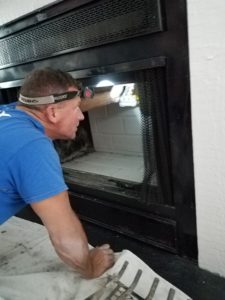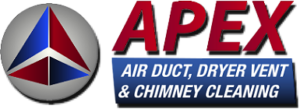Apex prides itself at being an expert in fireplace safety and we work hard at educating our technicians to thoroughly inspect and clean a wood burning fireplace.
Below is a sample of a Level 1 inspection process we follow.
Standard Operating Procedure
Level 1 Inspection
Factory-Built Fireplace


Introduction
NFPA 211 defines the inspection requirements for fireplaces and chimneys, and has
defined three levels of inspection. A Level One inspection is the recommended level of
inspection to use during routine chimney cleanings and annual inspections. Level One is
the appropriate inspection when “nothing is changing”. In other words, the fireplace
will continue to be used as it has been without significant change such as the addition of
a new appliance. A Level One inspection should include readily accessible portions of
the fireplace and chimney and accessible portions of connected appliances and the
chimney connection. Readily Accessible can be described as being quickly or easily
reached for inspection, maintenance or repair. Readily accessible would not require the
use of tools for opening or removal of any panel, door or other covering. Readily
accessible also does not require the use of ladders. Accessible could first require the
movement or removal of a panel, door or other covering. Accessible could require the
use of ladders or common hand tools such as a screwdriver or wrench. Neither Readily
Accessible nor Accessible would require removal of permanently attached components
or destructive actions to the building.
The NFPA 211 three levels of inspection are used as the standard in the chimney
service industry but may not be the code in effect in your area. Your service truck
should have a copy of NFPA 211 and the codes that are in use where you perform your
service. Many fireplaces do not conform to the construction requirements of the 211.
References made in this document are to information found in the NFPA 211 with the
understanding that the specifics of your local code may vary. Where there are
differences between NFPA 211 and your local adopted code with regard to chimney and
fireplace construction, you should follow local code but may elect to recommend
requirements from NFPA 211 if they are stricter.
Objective of a Level One Inspection
The Level 1 inspection is to be included with each sweep job. You must determine that
the system is not blocked or significantly restricted and is capable of continued use as is.
You are expected to determine the overall cleanliness of the venting system. This will
require opening the damper and using a light to look up the chimney and into the flue.
Sweep, or recommend sweeping, any chimney with 1/8th inch or greater buildup. This
level of inspection applies to all readily accessible portions of the chimney exterior and
Page 2 of 3 Rev. 4/5/19 ©Chimney Safety Institute of America. All Rights Reserved.
accessible portions of the appliance and chimney connection. You are expected to
determine that no blockage exists in the flue, which you may be able to determine
through visual inspection of the flue. In some cases, such as a flue with offsets, it might
be necessary to send a chimney brush through the system or do an internal camera
inspection.
If you plan to video scan the chimney set up the drop cloth and bring in the proper
equipment. Take pictures of irregularities within the chimney and save them for future
reference and comparison. Identify the photos with the date and location of the job.
While the video scanning is not a mandatory part of a Level 1 inspection, some
companies elect to provide the service in an effort to enhance the value of the
inspection and to document their service.
Look at the Fireplace
Perform a visual inspection of the fireplace. Look for staining above the fireplace
opening that would indicate that the fireplace has spilled smoke in the past. Also make
note of damaged accessories such as burned out grates, screens or glass doors in poor
condition. Look at the overall condition of the fireplace as well as the inner and outer
hearth. If the fireplace has damaged refractory panels or sheet metal, make a note of
that as well. Check to see if any air circulation grills or louvers on the fireplace have
been blocked or restricted by fireplace accessories, mantels or trim.
Hearth Condition & Sizing
Confirm the dimensions of the outer hearth based on the manufacturers’ installation
instructions, if they are available onsite at the time of your inspection. If the
manufacturer does not provide this information the hearth should be sized relative to
the fireplace opening according to the NFPA 211. Look for cracks anywhere on the
hearth with special emphasis between the outer hearth and the fireplace.
Combustibles surrounding the fireplace
Manufacturers’ installation instructions will define whether combustible material can
overlay the fireplace. It will also specify clearance requirements for the surrounding
trim and mantle. Many factory-built fireplaces allow combustibles materials up to the
side and top edges of the fireplace as long as the combustible material does not overlap
the fireplace facing. These construction details vary from manufacturer to
manufacturer.
Fireplace Installation
Note any gaps around the firebox opening where smoke could potentially move behind
the finished wall. If you see any gaps either above or to the side of the fireplace, note it
in your report.
Look in the Fireplace
Check the damper for closure. Does it move freely? Does it open enough to provide
sufficient space for the smoke to flow freely through it? Does the area immediately
above the damper appear to be fitted well? Many times a transition is required to mate
Page 3 of 3 Rev. 4/5/19 ©Chimney Safety Institute of America. All Rights Reserved.
the chimney to the top of the fireplace. Note any broken, damaged, rusted or missing
parts seen during your inspection.
Sweeping
If the chimney is so dirty you cannot complete the inspection you will have to sweep it
before you can fully evaluate the condition of the flue and liner. Make a note of the
volume or nature of the deposits found in the chimney. Whether sweeping from the
bottom or the top, listen for odd sounds that could indicate a separation in the chimney
or some unusual construction. If there are indications that there was a chimney fire,
take pictures and document your findings before sweeping the flue and recommend a
Level 2 inspection at this time. If the client declines the recommendation, make a note
in your report. It may be useful to ask the homeowner to contact their insurance
company and ask them if they prefer to have you sweep the chimney or if they would
rather you leave the evidence undisturbed.
A Level One inspection does not require rooftop access but if you choose to sweep the
chimney from the top you will be expected to look at the general condition of the
system above the roof including chimney, cap, storm collar and flashing (or chase cover).
Get an accurate measurement of the interior dimensions of the chimney. If there is a
rain cap make sure it is an approved type and not obstructed or restrictive. Make note
of missing, damaged, rusted or corroded parts of the system, to the extent they are
readily accessible.
Caps, Top Dampers and Draft Systems
Just as it is important to determine that the flue is not blocked and restricted, it is
likewise important to determine that any accessories installed at the top of the chimney
are not blocked or restricted. This includes chimney caps, spark arrestors, top dampers
and mechanical draft systems. Check these accessories to see if they are free from rust
or corrosion and that movable parts are operable.
Delivering Your Report to the Client
After you have completed the inspection, you should discuss your findings with the
client, provide them a copy of the report, and obtain their signature on the report.
Without the client signature it is difficult to prove that you informed them of the
conditions observed. You should maintain the inspection report in a permanent filing
system.
This Standard Operating Procedure (SOP) is promulgated by the Chimney Safety Institute of America (CSIA) solely
as general guidance for chimney sweep professionals. Since all operations are different and since it is not possible
to foresee all potential hazards, this SOP must be tailored to fit the needs of each particular operation. CSIA does
not warrant in any way whatsoever that adhering to this SOP will reveal every possible defect in an appliance,
fireplace, venting system or chimney. Accordingly, CSIA makes no guarantee, nor does it assume any responsibility,
for any damage, claim, or legal action that may arise in connection with a chimney sweep professional’s use of this
SOP.

